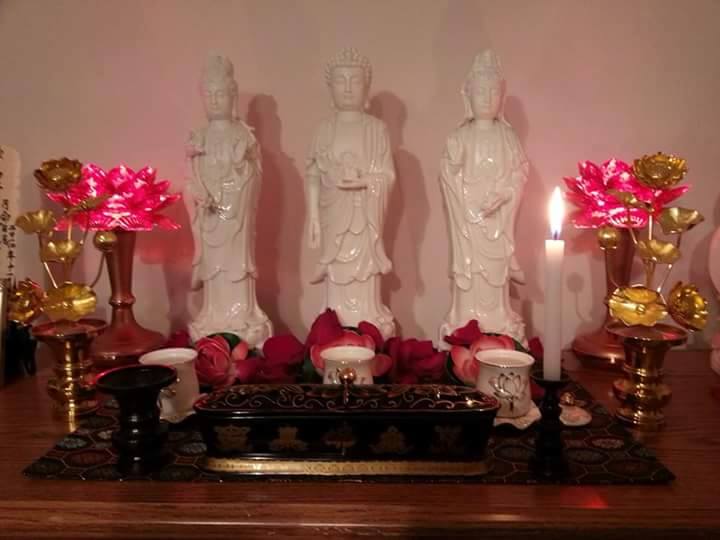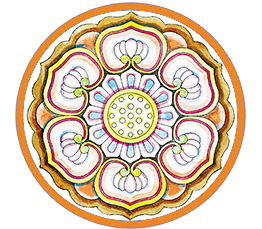From Orthodox Christianity to Amitabha's Pure Land
By James Jorgensen
An American Pure Land practitioner, James Jorgensen, wrote to Hongyuan Monastery (abbot: Master Jingzong) in March 2015. He introduced himself and asked a couple of questions relating to Pure Land practice. Here is James' letter, together with the reply by Master Zongdao:
Respectful greetings with palms together.
Dear Venerable Sirs, Namo Amitabha Buddha! Please accept my deepest gratitude for your English website. I have found so much peace and true understanding of our pristine Pure Land lineage. I am excited and look forward to seeing the website grow. Also, books translated into English that were only available in Chinese.
I am 47 years old. I live in Atlanta, Georgia, United States of America.
I was first attracted to pictures in books about world religions of Amitabha Buddha in the second grade of school. So, since childhood I have studied cultural anthropology to learn about spirituality around the world.
I was once an Eastern Orthodox Christian. In fact, I was a monk in the Church. But due to conditions in my life and the behavior of the Church hierarchy, I began to have serious doubts. Much, including science, could not be reconciled with traditional Church teachings. There was absolutely no hope of salvation for me in Christianity. I suffered much cruelty and abuse.
I have explored and researched many Dharma schools and traditions. I took the Eight Precepts in a Theravada temple many years ago. I found a deep appreciation of Mahayana Buddhism. I was fascinated with Esoteric Buddhist practices. But I found my true peace and contentment in Pure Land Buddhism. For many years I was confused by the many views of just what is Pure Land Buddhism from the different schools of Buddhist thought. One school in Japan even condemned Pure Land Buddhism as evil and assured everyone that all believers in Pure Land would fall into the deepest part of the Avici Hell. I had friends in this Japanese school of Buddhism, as it is popular in the United States. But now they will not speak to me because I have enshrined Amitabha Buddha and recite his name.
You cannot imagine my sheer joy and happiness to discover the pristine lineage and your website. I am trying to increase my recitation every day. Today I chanted two rounds on the 108-bead mala. I want to increase to ten rounds a day. I offer flowers, food, water, candles and incense to express my sincerest gratitude and love of Amitabha Buddha. He is very much a guiding parent in my tormented life. In my darkest loneliness, Amitabha Buddha is there always.
I have a couple of questions, after reading a translated Dharma talk on your website. A portion of the talk spoke about the sole devotional focus of a Dharma center being Amitabha Buddha. No other image should be displayed.
I have the Three Sacred Beings of the Pure Land enshrined on my home altar (pictured). Should I practice without the two Bodhisattvas, and enshrine only the image of Amitabha Buddha?

I could display the images of the Three Sacred Beings in another part of my home as a Dharma reminder of the Three Beings appearing at my death to take me to the Pure Land. Then enshrine a single large image of Amitabha Buddha as my singular focus of devotion for daily practice on the home altar.
My final question is what is our school’s teaching and practice to honor our deceased family members? My mother died in 1984 from brain cancer. She was only 37 years old. Two of my brothers died terrible deaths, both aged 33. Does our school offer memorial services and tablets for the deceased? Can I transfer the merit of my practice for my mother’s and brother’s peaceful rebirths in the Pure Land?
Thank you very much.
Respectfully and in gratitude,
James Jorgensen
Dear James,
Namo Amitabha Buddha! I am delighted to receive your email. It reminds me of a saying by an ancient worthy: “Amitabha-reciters travel the same path. Though separated by great distances, they are all brothers.”
Here are the answers to your two questions:
1) Should I practice without the two Bodhisattvas, and enshrine only the image of Amitabha Buddha on my home altar?
The Three Sacred Beings of the Western Land of Bliss – Bodhisattvas Avalokitesvara and Mahasthamaprapta, and Amitabha Buddha – were originally a single entity. It is no obstacle to rebirth in the Pure Land whether you enshrine all three or just Amitabha Buddha, the fundamental sacred being.
In terms of practical, psychological focus, however, it would be better if you could set aside the two Bodhisattvas and place them elsewhere – and, as you say, “enshrine a single large image of Amitabha Buddha as my singular focus of devotion for daily practice.” After all, enshrining Amitabha alone produces a clearer, more distinctive effect, allowing us to concentrate our minds on the only being who can deliver us, Amitabha Buddha.
2) On the deliverance of the spirits of deceased family members.
Only the merit from virtuous actions can enable the deceased to be born in one of the Fortunate Realms or the Pure Land. Amitabha-recitation itself contains the most splendid virtues. So if you can dedicate the merit from your recitation to your late mother and brothers, it would certainly help them gain rebirth in a Fortunate Realm or in the Pure Land. Of course, whether they would actually be reborn still depends on their own karma and virtuous roots.
As for memorial tablets, you can place them beneath the image of Amitabha Buddha. Your deceased family members would then be bathed daily in recitations of Amitabha’s name as well as in his light, and benefit therefrom. If you were to dedicate the merit from your recitation every day in front of the memorial tablets, the effect would probably be even better. Specialized deliverance services often induce stronger mind-to-mind resonances between their initiator and those being delivered. At Hongyuan Monastery in China, we have published a book titled Rites of Deliverance Through Amitabha-Recitation. We can arrange for some practically oriented highlights to be translated into English, so you can try them out.
Moreover, Householder Jingtu (Tom Polin) in Hong Kong and several other volunteers have published English translations of several of our texts. This is probably the material you saw on our website. Jingtu and the others intend before long to begin work on rendering the Three Pure Land Sutras and Master Shandao’s landmark Commentary on the Contemplation Sutra into English, and volunteers are welcome. Jingtu has organized an English page and discussion group on Pure Land Buddhism on Facebook. You can contact him at Tom Polin <kasmaytom@gmail.com>.
Shi Zongdao
Characteristics
- Recitation of Amitabha’s name, relying on his Fundamental Vow (the 18th)
- Rebirth of ordinary beings in the Pure Land’s Realm of Rewards
- Rebirth assured in the present lifetime
- Non-retrogression achieved in this lifetime

The 18th Vow of Amitabha Buddha
If, when I achieve Buddhahood, sentient beings of the ten directions who sincerely and joyfully entrust themselves to me, wish to be reborn in my land and recite my name, even ten times, should fail to be born there, may I not attain perfect enlightenment. Excepted are those who commit the five gravest transgressions or slander the correct Dharma.
Guiding Principles
Faith in, and acceptance of, Amitabha’s deliverance
Single-minded recitation of Amitabha’s name
Aspiration to rebirth in Amitabha’s Pure Land
Comprehensive deliverance of all sentient beings
